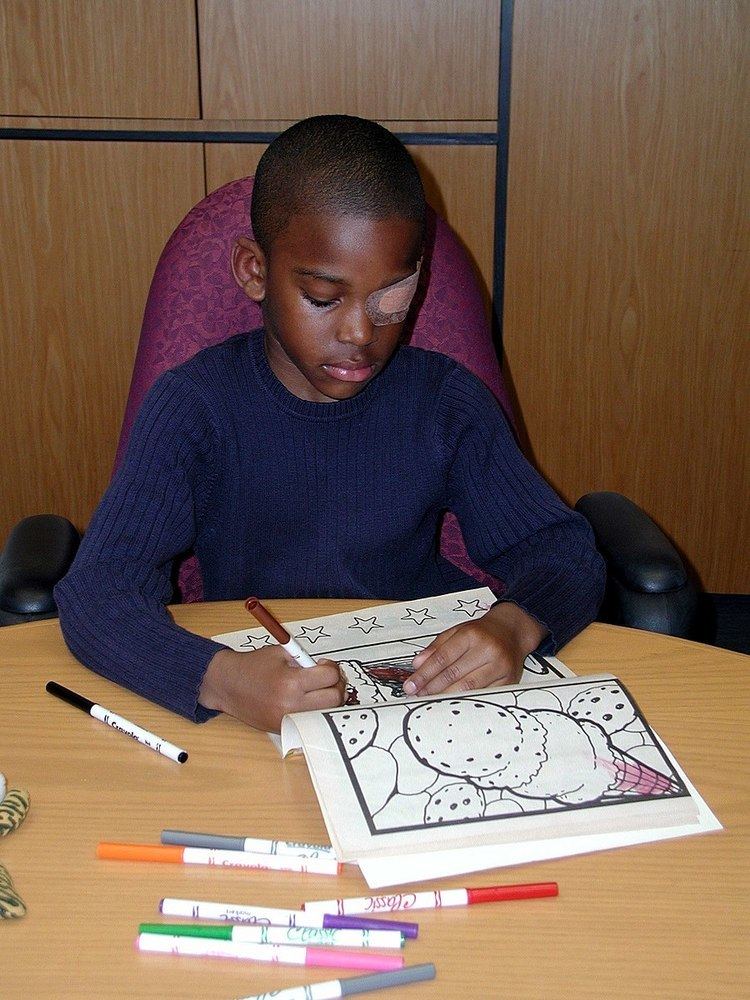 | ||
An eyepatch or eye pad is a small patch that is worn in front of one eye. It may be a cloth patch attached around the head by an elastic band or by a string, an adhesive bandage, or a plastic device which is clipped to a pair of glasses. It is often worn by people to cover a lost or injured eye, but it also has a therapeutic use in children for the treatment of amblyopia. (See orthoptics and vision therapy.) Eyepatches used to block light while sleeping are referred to as a sleep mask. Eyepatches associated with pirates are a stereotype originating from fiction.
Contents
An eyepad or eye pad is a soft medical dressing that can be applied over an eye to protect it. It is not necessarily the same as an eyepatch.
History
In the years before advanced medicine and surgery, eyepatches were common for people who had lost an eye. They were particularly prevalent among members of dangerous occupations, such as soldiers and sailors who could lose an eye in battle, as well as blacksmiths who used them to cover one eye for protection from sparks while working. While stereotypically associated with pirates, there is no evidence to suggest the historicity of eye patch wearing pirates before several popular novels of the 19th century (see Pirate Eyepatches below).
Amblyopia
Eye patching is used in the orthoptic management of children at risk of lazy eye (amblyopia), especially strabismic or anisometropic amblyopia. These conditions can cause visual suppression of areas of the dissimilar images by the brain such as to avoid diplopia, resulting in a loss of visual acuity in the suppressed eye and in extreme cases in blindness in an otherwise functional eye. Patching the good eye forces the amblyopic eye to function, thereby causing vision in that eye to be retained. It is important to perform “near activities” (such as reading or handiwork) when patched, thereby exercising active, attentive vision.
A study provided evidence that children treated for amblyopia with eye patching had lower self-perception of social acceptance. To avoid a child from being socially marginalized by its peers due to the wearing of an eye patch, atropine eye drops may be used instead. This induces temporary blurring in the treated eye.
It has been pointed out that the penalization of one eye by means of patching or atropine drops does not provide the conditions that are necessary in order to develop or improve binocular vision. Recently, efforts have been made to propose alternative treatments of amblyopia that do allow for the improvement of binocular sight, for example using binasal occlusion or partially frosted spectacles in place of any eye patch, using alternating occlusion goggles or using methods of perceptual learning based on video games or virtual reality games for enhancing binocular vision.
A 2014 Cochrane Review sought to determine the effectiveness of occlusion treatment on patients with sensory deprivation amblyopia, however no trials were found eligible to be included in the review. However, it is suggested that good outcomes from occlusion treatment for sensory deprivation amblyopia rely on compliance with the treatment.
Extraocular muscle palsy
To initially relieve double vision (diplopia) caused by an extra-ocular muscle palsy, an eye care professional may recommend using an eyepatch. This can help to relieve the dizziness, vertigo and nausea that are associated with this form of double vision.
Aircraft pilots
Aircraft pilots used to use an eye patch, or close one eye to preserve night vision when there was disparity in the light intensity within or outside their aircraft, such as when flying at night over brightly lit cities, so that one eye could look out, and the other would be adjusted for the dim lighting of the cockpit to read unlit instruments and maps. The FAA still recommends, "a pilot should close one eye when using a light to preserve some degree of night vision". Some military pilots have worn a lead-lined or gold-lined eyepatch, to protect against blindness in both eyes, in the event of a nuclear blast or laser weapon attack.
Eyepatches are not currently used by military personnel; modern technology has provided an array of other means to preserve and enhance night vision, including red-light and low-level white lights, and night vision devices.
Pirates
It is a stereotype that pirates during the age of sail often wore eyepatches. This stereotype is common in fiction and was popularized by the novel Treasure Island. Its wearing by a pirate was first attributed to Rahmah ibn Jabir al-Jalahimah.
A "pirate night vision" myth asserts that pirates wore a patch over one eye in preparation for battle in order to have one eye adjusted to above-deck daylight and the other adjusted to below-deck darkness. The myth supposes that during raids pirates would remove their patches when going below deck and thus be instantly granted one-eyed night vision to easily navigate the ship's dim interior. Although an interesting idea, the loss of depth perception during the critical period of boarding and seizing control of a vessel would be an incredibly large price to pay in order to see better when going below deck, making this myth implausible.
The myth of pirate night vision has no basis in fact. While it does take time for the human eye to adjust to optimum vision when switching between dark and brightly lit areas, there is no evidence to suggest that such a tactic was ever employed by pirates or anyone else. No naval combat manual or historical account of the era makes any reference to such tactics ever being used.
